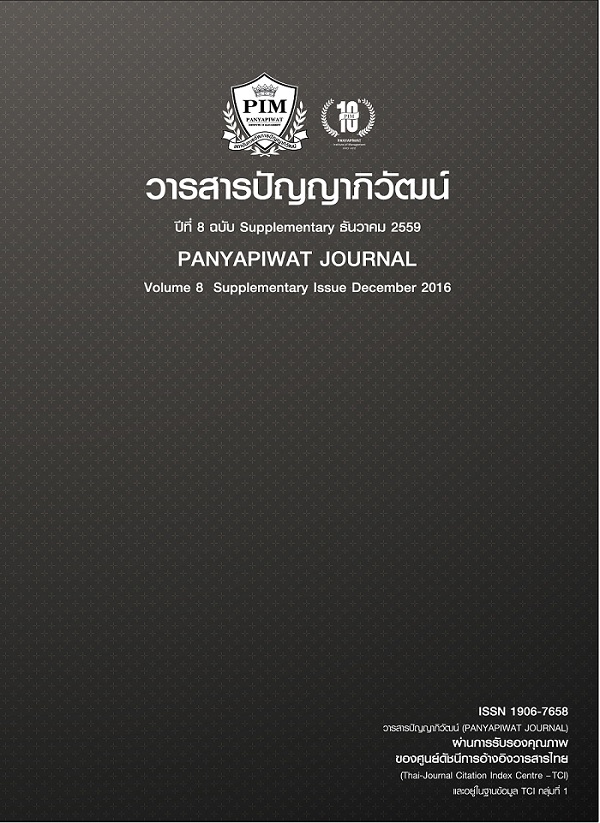THE DIFFERENCE IN IMPACTS OF SUPPLY CHAIN CAPITAL STRUCTURES ON CUSTOMER AND SUPPLIER COLLABORATION IN MANUFACTURING FIRMS IN THAILAND
Main Article Content
บทคัดย่อ
Effective and efficient firm collaborations with suppliers and customers can lead to improving supply chain performance and stimulate firm growth. This paper investigated customer and supplier collaboration within the different types of supply chain capital structures. We focus on pure Thai, pure MNCs, pure Join Venture, export, and import supply chain capital structures. The data, collected from 2012-2015, consist of 939 responses from manufacturing firms, located in Thailand. One-way ANOVA method is used to analyze the data. The results indicate that at least one type of supply chain capital structure is significantly different from other types of all factors relating to customer collaboration and supplier collaboration. Based on our Post-hoc Analysis, pure MNCs chain and pure JVs chain are significantly different in the supply chain collaboration from the other three chains. However, there is no significant difference in the supply chain collaboration between the group of pure MNCs chain and pure JVs chain.
ความร่วมมือระหว่างซัพพลายเออร์และลูกค้าที่ดีสามารถเพิ่มประสิทธิภาพของห่วงโซ่อุปทานและกระตุ้นให้บริษัทเติบโต งานวิจัยนี้ศึกษาเปรียบเทียบความร่วมมือระหว่างบริษัทในห่วงโซ่อุปทานในรูปแบบต่างๆ ที่ประกอบไปด้วยห่วงโซ่ของบริษัทไทยทั้งหมด (Pure Domestics Chain) ห่วงโซ่ของบริษัทต่างชาติทั้งหมด (Pure MNCs Chain) ห่วงโซ่ของบริษัทร่วมทุนทั้งหมด (Pure Joint Venture Chain) ห่วงโซ่ที่มีลูกค้าเป็นบริษัทต่างชาติ (Export Chain) ห่วงโซ่ที่มีซัพพลายเออร์เป็นบริษัทต่างชาติ (Import Chain) โดยใช้ข้อมูลแบบสอบถามที่จัดเก็บระหว่างปี 2555-2558 ซึ่งมีทั้งหมด 939 บริษัทที่ทำการผลิตและอยู่ในประเทศไทย จากการวิเคราะห์ผ่านค่าความแปรปรวน (One-way ANOVA) พบว่ามีรูปแบบของห่วงโซ่อย่างน้อยหนึ่งรูปแบบที่แตกต่างจากห่วงโซ่อื่นๆ ในทุกปัจจัยของความร่วมกับบริษัทลูกค้าและทุกปัจจัยของความร่วมมือกับซัพพลายเออร์ โดยจากการวิเคราะห์เพิ่มเติม (Post-hoc Analysis) พบว่าห่วงโซ่ที่ประกอบด้วยบริษัทต่างชาติทั้งหมดและห่วงโซ่ที่ประกอบด้วยบริษัทร่วมทุนทั้งหมด มีความแตกต่างอย่างชัดเจนในด้านความร่วมมือกันระหว่างบริษัทในห่วงโซ่ เมื่อเทียบกับห่วงโซ่รูปแบบอื่นๆ แต่ห่วงโซ่ทั้งสองรูปแบบนี้ไม่มีความแตกต่างกันอย่างชัดเจนในด้านความร่วมมือกันระหว่างบริษัทในห่วงโซ่
Article Details
“ข้าพเจ้าและผู้เขียนร่วม (ถ้ามี) ขอรับรองว่า บทความที่เสนอมานี้ยังไม่เคยได้รับการตีพิมพ์และไม่ได้อยู่ระหว่างกระบวนการพิจารณาลงตีพิมพ์ในวารสารหรือแหล่งเผยแพร่อื่นใด ข้าพเจ้าและผู้เขียนร่วมยอมรับหลักเกณฑ์การพิจารณาต้นฉบับ ทั้งยินยอมให้กองบรรณาธิการมีสิทธิ์พิจารณาและตรวจแก้ต้นฉบับได้ตามที่เห็นสมควร พร้อมนี้ขอมอบลิขสิทธิ์บทความที่ได้รับการตีพิมพ์ให้แก่สถาบันการจัดการปัญญาภิวัฒน์หากมีการฟ้องร้องเรื่องการละเมิดลิขสิทธิ์เกี่ยวกับภาพ กราฟ ข้อความส่วนใดส่วนหนึ่งและ/หรือข้อคิดเห็นที่ปรากฏในบทความข้าพเจ้าและผู้เขียนร่วมยินยอมรับผิดชอบแต่เพียงฝ่ายเดียว”
References
Alarcón, S. & Sánchez, M. (2013). External and Internal R&D, Capital Investment and Business Performance in the Spanish Agri-Food Industry. Journal of Agricultural Economics, 64(3), 654-675.
Baregheh, A., Hemsworth, D., Rowley, J. & Davies, D. (2012). The effect of organizational characteristics on position and paradigm innovation. Paper presented at the ISPIM Innovation Symposium.
Cao, M. & Zhang, Q. (2011). Supply chain collaboration: Impact on collaborative advantage and firm performance. Journal of Operations Management, 29(3), 163-180.
Cucculelli, M., Le Breton-Miller, I. & Miller, D. (2016). Product innovation, firm renewal and family governance. Journal of Family Business Strategy, 7(2), 90-104.
Dyer, J. H. & Nobeoka, K. (2000). Creating and managing a high-performance knowledge-sharing network: the Toyota case. Strategic management journal, 21(3), 345-367.
Dzhumashev, R., Mishra, V. & Smyth, R. (2016). Exporting, R&D investment and firm survival in the Indian IT sector. Journal of Asian Economics, 42, 1-19.
Fawcett, S. E., Wallin, C., Allred, C., Fawcett, A. M. & Magnan, G. M. (2011). Information technology as an enabler of supply chain collaboration: a dynamic-capabilities perspective. Journal of Supply Chain Management, 47(1), 38-59.
Huang, K. F., Lin, K. H., Wu, L. Y. & Yu, P. H. (2015). Absorptive capacity and autonomous R&D climate roles in firm innovation. Journal of Business Research, 68(1), 87-94.
Hudnurkar, M., Jakhar, S. & Rathod, U. (2014). Factors Affecting Collaboration in Supply Chain: A Literature Review. Procedia - Social and Behavioral Sciences, 133, 189-202.
Karabulut, A. T. (2015). Effects of Innovation Strategy on Firm Performance: A Study Conducted on Manufacturing Firms in Turkey. Procedia - Social and Behavioral Sciences, 195, 1338-1347.
Maietta, O. W. (2015). Determinants of university–firm R&D collaboration and its impact on innovation: A perspective from a low-tech industry. Research Policy, 44(7), 1341-1359.
Manders, B., de Vries, H. J. & Blind, K. (2016). ISO 9001 and product innovation: A literature review and research framework. Technovation, 48-49, 41-55.
Mantovani, A. (2006). Complementarity between product and process innovation in a monopoly setting. Economics of Innovation and New Technology, 15(3), 219-234.
Martinez-Ros, E. (1999). Explaining the decisions to carry out product and process innovations: The Spanish case. The Journal of High Technology Management Research, 10(2), 223-242.
Nonaka, I. & Konno, N. (1998). The Concept of “Ba”: BUILDING A FOUNDATION FOR KNOWLEDGE CREATION. California management review, 40(3), 40-54.
Nonaka, I. & Takeuchi, H. (1995). The knowledge-creating company: How Japanese companies create the dynamics of innovation. Oxford university press.
OECD. (2013). “Thailand: innovation profile”, in innovation Southeast Asia. OECD Publishing.Petsas, I. & Giannikos, C. (2005). Process versus product innovation in multiproduct firms. International Journal of Business and Economics, 4(3), 231-248.
Reichstein, T. & Salter, A. (2006). Investigating the sources of process innovation among UK manufacturing firms. Industrial and Corporate Change, 15(4), 653-682.
Samaddar, S. & Kadiyala, S. S. (2006). An analysis of interorganizational resource sharing decisions in collaborative knowledge creation. European Journal of Operational Research, 170(1), 192-210.
Simatupang, T. M. & Sridharan, R. (2005). An integrative framework for supply chain collaboration. The International Journal of Logistics Management, 16(2), 257-274.
Simatupang, T. M. & Sridharan, R. (2008). Design for supply chain collaboration. Business Process Management Journal, 14(3), 401-418.
Simatupang, T. M., Wright, A. C. & Sridharan, R. (2004). Applying the theory of constraints to supply chain collaboration. Supply Chain Management: An International Journal, 9(1), 57-70.
Sterlacchini, A. (1999). Do innovative activities matter to small firms in non-R&D-intensive industries? An application to export performance. Research Policy, 28(8), 819-832.
Thailand Industrialization and Ecomomic Catch-up. (2015). Philippines: Asia Development Bank.
Vega-Jurado, J., Gutiérrez-Gracia, A., Fernández-de-Lucio, I. & Manjarrés-Henríquez, L. (2008). The effect of external and internal factors on firms’ product innovation. Research Policy, 37(4), 616-632.
Wong, C. W. Y., Wong, C. Y. & Boon-itt, S. (2013). The combined effects of internal and external supply chain integration on product innovation. International Journal of Production Economics, 146(2), 566-574.
Zhang, M. & Yin, X. (2012). The Effect of R&D Alliances on the Speed of Innovation: Evidence from Chinese SMEs. Physics Procedia, 25, 1155-1161.

